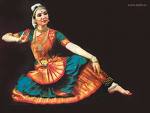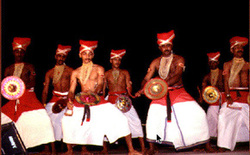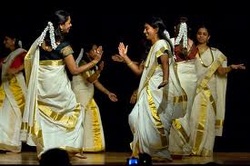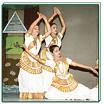Kerala Arts
Classical Arts of Kerala
.

Bharata Natyam :
It is believed to be india's oldest form of classical dance. This dance form which is called poetry in motion, has its hoary origins in the natya sastra written about 4000 b.c. by sage bharatha. This art form grossly disallows new fangled innovations or gimmicks except in repertoire and forms of presentation. It was originally known as 'dasi attam,' a temple art performed by young women called 'devadasis.'
Bharatha natyam is commonly performed by women, but sometimes by men also. There are strict guidelines laid down regarding every single aspect of the art including the attributes required in order to be an accomplished dancer.
It is believed to be india's oldest form of classical dance. This dance form which is called poetry in motion, has its hoary origins in the natya sastra written about 4000 b.c. by sage bharatha. This art form grossly disallows new fangled innovations or gimmicks except in repertoire and forms of presentation. It was originally known as 'dasi attam,' a temple art performed by young women called 'devadasis.'
Bharatha natyam is commonly performed by women, but sometimes by men also. There are strict guidelines laid down regarding every single aspect of the art including the attributes required in order to be an accomplished dancer.
.

Chakyarkoothu :
Also called koothu, is one of the oldest classical theatre arts of kerala. The solo dance is usually presented in the koothambalam of temples to the accompaniment of the mizhavu and elathalam. The performance begains with an invocation to the presiding deity of the temple. The narration is enlivened with the thandava dance movements, gestures and facial expression according to the guidelines in natya sastra. Koothu is distinct for its comic element which adds to its dramatic character. Themes are usually from the epics. The costume is colourful and bizarre with a strange headgear
Also called koothu, is one of the oldest classical theatre arts of kerala. The solo dance is usually presented in the koothambalam of temples to the accompaniment of the mizhavu and elathalam. The performance begains with an invocation to the presiding deity of the temple. The narration is enlivened with the thandava dance movements, gestures and facial expression according to the guidelines in natya sastra. Koothu is distinct for its comic element which adds to its dramatic character. Themes are usually from the epics. The costume is colourful and bizarre with a strange headgear
.

Kathakali :
This spectacular classical dance drama of kerala based on the guidelines laid by sage bharatha's natya sastra, the ancient treatise on dance and drama, is over 500 years old. This elaborate art form is usually performed in the evenings and continues up to dawn, and is an integral part of all temple and cultural festivals in kerala. The costumes and makeup are ornamental, elaborate and designed to give a superhuman effect. The actors do not speak or sing but enact the story through mudras (hand gestures), graceful movements and facial expressions. The themes of this awe inspiring art are taken from india's rich and colourful mythology. Music is an essential feature of kathakali, with two vocalists who sing to the accompaniment of a chengila (gong), elathalam (small cymbals), chenda and maddalam.
This spectacular classical dance drama of kerala based on the guidelines laid by sage bharatha's natya sastra, the ancient treatise on dance and drama, is over 500 years old. This elaborate art form is usually performed in the evenings and continues up to dawn, and is an integral part of all temple and cultural festivals in kerala. The costumes and makeup are ornamental, elaborate and designed to give a superhuman effect. The actors do not speak or sing but enact the story through mudras (hand gestures), graceful movements and facial expressions. The themes of this awe inspiring art are taken from india's rich and colourful mythology. Music is an essential feature of kathakali, with two vocalists who sing to the accompaniment of a chengila (gong), elathalam (small cymbals), chenda and maddalam.
.

Mohiniyattam :
This classical solo dance form combines the graceful elegance of bharatanatyam with the vigour and dynamism of kathakali, to create a mood that is predominantly sringara (erotic). The dance is usually performed on specially put up stages in connection with temple festivals. The costume is the traditional white mundu and melmundu of kerala. The hair is gathered and put up at the side of the head and adorned with jasmine, int the traditional style
This classical solo dance form combines the graceful elegance of bharatanatyam with the vigour and dynamism of kathakali, to create a mood that is predominantly sringara (erotic). The dance is usually performed on specially put up stages in connection with temple festivals. The costume is the traditional white mundu and melmundu of kerala. The hair is gathered and put up at the side of the head and adorned with jasmine, int the traditional style
Traditional Arts

AMBALAPUZHA VELAKALI
Velakali is a group dance held in the open air as an exhibition of the martial feats in front of the raja (king) of Ambalapuzha (erstwhile Chempakassery), who wanted to see how his soldiers had performed in the wars. This show meant to be witnessed by the deity of the temple which is taken out in procession to the courtyard of the temple on a caparisoned elephant. The play consist of a procession in the beginning in which, the dancers walk in line through the village road holding the sword made of rattan in the right-hand and a shield in the left. They move elegantly keeping their pace to the rhythm followed by a hilarious group of villagers encouraging the dancers by jumping and singing and waving small colourful flags. By dusk 'Kulathil vela' or the play on the bank of the tank commences. The dancers take their position on the bank of the temple tank and with weapons in their hands start the play moving their bodies. Their movements get reflected in the water probably reminding one of the war in the sea or rivers. On the other side of the tank the caparisoned elephant with the deity takes position. The dancers do not change their position but exhibit only the swaying of their bodies to the rhythm of Velappara, the main percussion instrument. Then the dancers disperse to assemble again in the southern quadrangle of the temple to start the regular exhibition of the feats. There the deity appears on the elephant. By about 8 p.m. 'Tirumunpil vela' or the play before the divine presence of the deity, start.
Now "Ambalapuzha Velakali" is performed every year inside the temple premise during the March-April 10 festival days except on the first and last days.
Velakali is a group dance held in the open air as an exhibition of the martial feats in front of the raja (king) of Ambalapuzha (erstwhile Chempakassery), who wanted to see how his soldiers had performed in the wars. This show meant to be witnessed by the deity of the temple which is taken out in procession to the courtyard of the temple on a caparisoned elephant. The play consist of a procession in the beginning in which, the dancers walk in line through the village road holding the sword made of rattan in the right-hand and a shield in the left. They move elegantly keeping their pace to the rhythm followed by a hilarious group of villagers encouraging the dancers by jumping and singing and waving small colourful flags. By dusk 'Kulathil vela' or the play on the bank of the tank commences. The dancers take their position on the bank of the temple tank and with weapons in their hands start the play moving their bodies. Their movements get reflected in the water probably reminding one of the war in the sea or rivers. On the other side of the tank the caparisoned elephant with the deity takes position. The dancers do not change their position but exhibit only the swaying of their bodies to the rhythm of Velappara, the main percussion instrument. Then the dancers disperse to assemble again in the southern quadrangle of the temple to start the regular exhibition of the feats. There the deity appears on the elephant. By about 8 p.m. 'Tirumunpil vela' or the play before the divine presence of the deity, start.
Now "Ambalapuzha Velakali" is performed every year inside the temple premise during the March-April 10 festival days except on the first and last days.
.

THEYYAM
A ritual dance performed in temples by appointed people in fulfillment of vows of devotees. Theyyam is the corrupted form of the word Daivam meaning the God. It is purported to be the dance by the Goddess Herself. The dancers are men in feminine attire wearing colourful costumes made usually of palm leaves, cloth and brass jewellery, ferocious masks and big head gear, often extending up to forty feet in height. The pace of the dance is set to the beating of Chenda (drum). The artiste invested by the goddess in his person falls in a trance, dances deliriously to the mounting tempo and conveys, as an oracle, the goddess's acceptance of the vow and blessings or otherwise.
A ritual dance performed in temples by appointed people in fulfillment of vows of devotees. Theyyam is the corrupted form of the word Daivam meaning the God. It is purported to be the dance by the Goddess Herself. The dancers are men in feminine attire wearing colourful costumes made usually of palm leaves, cloth and brass jewellery, ferocious masks and big head gear, often extending up to forty feet in height. The pace of the dance is set to the beating of Chenda (drum). The artiste invested by the goddess in his person falls in a trance, dances deliriously to the mounting tempo and conveys, as an oracle, the goddess's acceptance of the vow and blessings or otherwise.
.

THIRUVATHIRA KALI
This is a group dance by young ladies of Nair community on the night of Thiruvathira (the sixth lunar asterism) of the month of Dhanu in the Malayalam calendar, corresponding to December in Christian era, till dawn, singing in praise of Lord Shiva. For married women it is an imperative ritual propitiating the God for granting lingering matrimony and for virgin maids, it is for the boon of getting a pleasing matrimonial alliance. Attired in traditional white handloom Mundu and Neryath and adorning fabulous gold jewellery, women dance round the Nilavilakku (pedestal wick lamp) placed in the courtyard, singing and clapping hands. It has songs written specifically for the purpose in special metric scale, narrating stories from the legends.
This is a group dance by young ladies of Nair community on the night of Thiruvathira (the sixth lunar asterism) of the month of Dhanu in the Malayalam calendar, corresponding to December in Christian era, till dawn, singing in praise of Lord Shiva. For married women it is an imperative ritual propitiating the God for granting lingering matrimony and for virgin maids, it is for the boon of getting a pleasing matrimonial alliance. Attired in traditional white handloom Mundu and Neryath and adorning fabulous gold jewellery, women dance round the Nilavilakku (pedestal wick lamp) placed in the courtyard, singing and clapping hands. It has songs written specifically for the purpose in special metric scale, narrating stories from the legends.
.

CHAVITTUNATAKAM
A Christian dance drama developed exclusively in Kerala as a counterpart of Kathakali enacted in Hindu temples. Unlike other performing arts, this drama is presented on a raised platform made of planks spread on skeleton wood structure. Actors don in colourful Roman attires enacts stories from Bible with rich dialogues and songs to the accompaniment of beating of country drums. The predominant feature of this art is the artistes stamping (Chavittu) the dance floor producing resonant sounds to accentuate the dramatic situations.
A Christian dance drama developed exclusively in Kerala as a counterpart of Kathakali enacted in Hindu temples. Unlike other performing arts, this drama is presented on a raised platform made of planks spread on skeleton wood structure. Actors don in colourful Roman attires enacts stories from Bible with rich dialogues and songs to the accompaniment of beating of country drums. The predominant feature of this art is the artistes stamping (Chavittu) the dance floor producing resonant sounds to accentuate the dramatic situations.
.

MARKKAM KALI
It is a counterpart of Thiruvathira Kali played by women belonging to the Christian community. Here also the dancers attired in traditional white mundu frilled at the back to cover the buttocks, chatta (Jacket), rich jewellery including Mekkamothiram (an ornamental ring worn by the Christian ladies on the upper lobe of the ear, now considered old fashioned). The dancers sing in praise of Jesus Christ to the varying rhythms of drum beating. It is comparatively brisk in action.
It is a counterpart of Thiruvathira Kali played by women belonging to the Christian community. Here also the dancers attired in traditional white mundu frilled at the back to cover the buttocks, chatta (Jacket), rich jewellery including Mekkamothiram (an ornamental ring worn by the Christian ladies on the upper lobe of the ear, now considered old fashioned). The dancers sing in praise of Jesus Christ to the varying rhythms of drum beating. It is comparatively brisk in action.
.

OPPANA
Oppana is makeup. This is dance by Muslims girls while doing bridal makeup. It is an all girls' performance in the bridal chamber. Friends and other girls of the bride's age sing to the rhythm of clapping hands in fast tempo and dance teasing the bride on the eve of marriage preparing her for the ceremony doing her face make up, manicuring and applying henna on the palms and feet.
Oppana is makeup. This is dance by Muslims girls while doing bridal makeup. It is an all girls' performance in the bridal chamber. Friends and other girls of the bride's age sing to the rhythm of clapping hands in fast tempo and dance teasing the bride on the eve of marriage preparing her for the ceremony doing her face make up, manicuring and applying henna on the palms and feet.
.

KALARIPPAYATTU
It is a form of martial arts practised by Hindus. The available historical evidences date it back to the 12th Century and historians believe that it is the oldest form of martial art in the world. Probably, it is the source of the world famous Karate of Japan. 'Kalari' is a school of martial arts derivative of the Sanskrit word 'Kholoorika' meaning military training centre and 'payattu' the fight. There were Kalaris strewn around the state which are recognized by the Government as the official training centres for new recruits in the armed force.
The instruction and practical training in this art is imparted inside the Kalari, a specially constructed hall with ample space of fighting floor with idols of all the presiding deities of the art and photographs of the entire lineage of Gurus. The idols and Gurus are worshipped before the beginning of the practice with all rituals and singing of hymns as in a temple. The master reverently addressed as 'Gurukkal' is deemed the representative of the God of war and the present link with the long line of Gurus gone deified into the back of beyond.
The pupils are trained in self-discipline and physical culture. Before the pupils are initiated into the techniques of warfare, their bodies are toned pliable, agile and versatile by regular massage by feet and hands with medicated oil. Then taught to wield Kuruvadi (short sticks), spear, dagger, sword, shield, etc. The last and sophisticated piece in the weaponry is 'Urumi' a thin springy three-meter long double edged sword worn around the waist locked like a belt drawn unwound in a flick of a moment when required. It is highly lethal for an adept wielder can aim it to swirl around the neck of the opponent and, at the slightest jerk, the head will roll on the floor of the arena.
Flying feats, daring onslaughts and dodging with dexterity are the ways in combat. Defensive and offensive strikes with lightning speed are its peculiarity. There are customarily eighteen 'adavu' (tricks) in this warfare. Seventeen, fighting with all the weapons one by one, the eighteenth being 'Poozhikkadakan', a feat producing a cover of whirlwind of dust around the combatant by stamping the earth and swift circular movement to camouflage him from the opponent and to take him by surprise with sudden retaliatory deathblow.
It is a form of martial arts practised by Hindus. The available historical evidences date it back to the 12th Century and historians believe that it is the oldest form of martial art in the world. Probably, it is the source of the world famous Karate of Japan. 'Kalari' is a school of martial arts derivative of the Sanskrit word 'Kholoorika' meaning military training centre and 'payattu' the fight. There were Kalaris strewn around the state which are recognized by the Government as the official training centres for new recruits in the armed force.
The instruction and practical training in this art is imparted inside the Kalari, a specially constructed hall with ample space of fighting floor with idols of all the presiding deities of the art and photographs of the entire lineage of Gurus. The idols and Gurus are worshipped before the beginning of the practice with all rituals and singing of hymns as in a temple. The master reverently addressed as 'Gurukkal' is deemed the representative of the God of war and the present link with the long line of Gurus gone deified into the back of beyond.
The pupils are trained in self-discipline and physical culture. Before the pupils are initiated into the techniques of warfare, their bodies are toned pliable, agile and versatile by regular massage by feet and hands with medicated oil. Then taught to wield Kuruvadi (short sticks), spear, dagger, sword, shield, etc. The last and sophisticated piece in the weaponry is 'Urumi' a thin springy three-meter long double edged sword worn around the waist locked like a belt drawn unwound in a flick of a moment when required. It is highly lethal for an adept wielder can aim it to swirl around the neck of the opponent and, at the slightest jerk, the head will roll on the floor of the arena.
Flying feats, daring onslaughts and dodging with dexterity are the ways in combat. Defensive and offensive strikes with lightning speed are its peculiarity. There are customarily eighteen 'adavu' (tricks) in this warfare. Seventeen, fighting with all the weapons one by one, the eighteenth being 'Poozhikkadakan', a feat producing a cover of whirlwind of dust around the combatant by stamping the earth and swift circular movement to camouflage him from the opponent and to take him by surprise with sudden retaliatory deathblow.
.

CHERUMARKALI
It is a harvest dance in which the dancer, both men and women move in a swift rhythm, linked in a back lock or holding arms. The costumes are in striking red and white.
It is a harvest dance in which the dancer, both men and women move in a swift rhythm, linked in a back lock or holding arms. The costumes are in striking red and white.
.

KAALA VELA
It is a spectacular procession of huge, gaudily decorated motifs of bulls (Kaala).
It is a spectacular procession of huge, gaudily decorated motifs of bulls (Kaala).
.

KALAMPATTU- Kalamezhuthu Pattu
It is another folk art form that belongs to the northern regions of Kerala. This art form which is over 600 years old is performed by a group of five or fifteen people in Bhadrakali and Ayyappa temples. The rituals is performed around the Kolam - an elaborated picture , usually of Bhadrakali, drawn on the floor, using five colours. The performance in the light of temple torches lasts through the night. The singers are neatly dressed with women their hair on the side of the head. Aseries of songs (Kalampattu) are sung to the accompaniment of nanthuni and elathalam.
It is another folk art form that belongs to the northern regions of Kerala. This art form which is over 600 years old is performed by a group of five or fifteen people in Bhadrakali and Ayyappa temples. The rituals is performed around the Kolam - an elaborated picture , usually of Bhadrakali, drawn on the floor, using five colours. The performance in the light of temple torches lasts through the night. The singers are neatly dressed with women their hair on the side of the head. Aseries of songs (Kalampattu) are sung to the accompaniment of nanthuni and elathalam.
.

KALIYOOTTU
It is an eight day long colourful folk which re-enacts the combat between goddess Durga and the demon Darika. The ritual is performed in different stages. The climax of the play - the ritual called Paranettu - is performed on a specially constructed 100 feet high stage on the eight day.
It is an eight day long colourful folk which re-enacts the combat between goddess Durga and the demon Darika. The ritual is performed in different stages. The climax of the play - the ritual called Paranettu - is performed on a specially constructed 100 feet high stage on the eight day.
.

KANNIYARKALI- Deshathukali
In which is a ritual art and swift dance form , performed to the accompaniment of devotional songs and the resounding drum beats is usually performed in Bhagavathy temples.
In which is a ritual art and swift dance form , performed to the accompaniment of devotional songs and the resounding drum beats is usually performed in Bhagavathy temples.
.

KAVADIYATTAM
It is a ritual dance offering in Subramanya Temples. The group of devotees wearing bright yellow or saffron costumes with ash smeared all over the body, dance in a frenzy carrying Kavadis. on their shoulders. Kavadis are colorful bow shaped wooden structure rising six to ten feet high. The ambalakavadi is structured and decorated like a temple. The Pookavadi has clusters of colorful papers, cloth or plastic flowers arranged on them. The resounding beats of percussion instruments like Udukku and Chenda and the Nadaswaram are characteristic of the kavadi procession
It is a ritual dance offering in Subramanya Temples. The group of devotees wearing bright yellow or saffron costumes with ash smeared all over the body, dance in a frenzy carrying Kavadis. on their shoulders. Kavadis are colorful bow shaped wooden structure rising six to ten feet high. The ambalakavadi is structured and decorated like a temple. The Pookavadi has clusters of colorful papers, cloth or plastic flowers arranged on them. The resounding beats of percussion instruments like Udukku and Chenda and the Nadaswaram are characteristic of the kavadi procession
